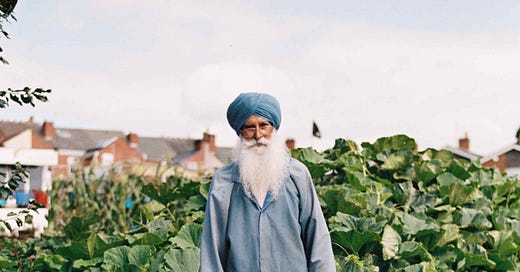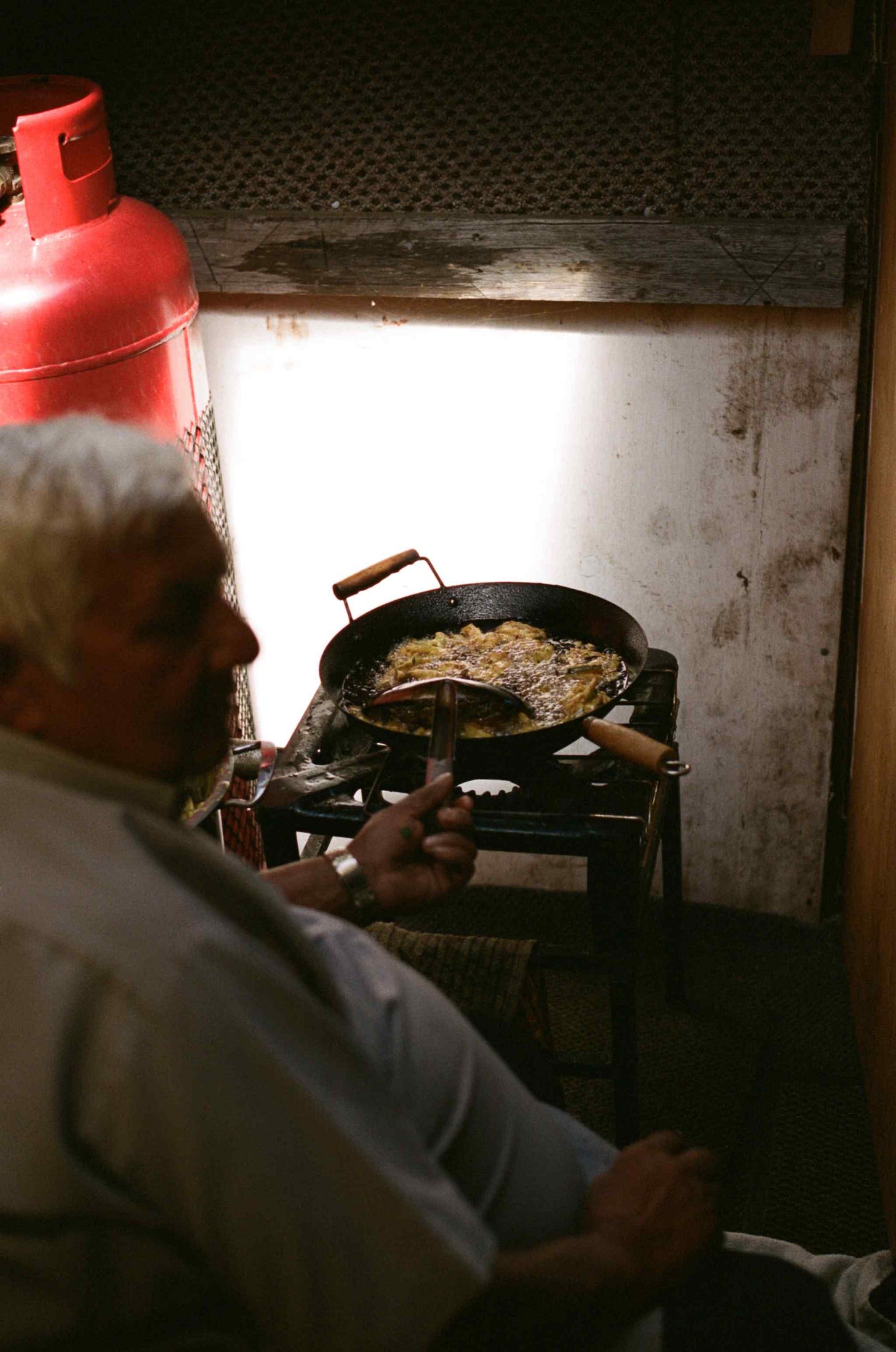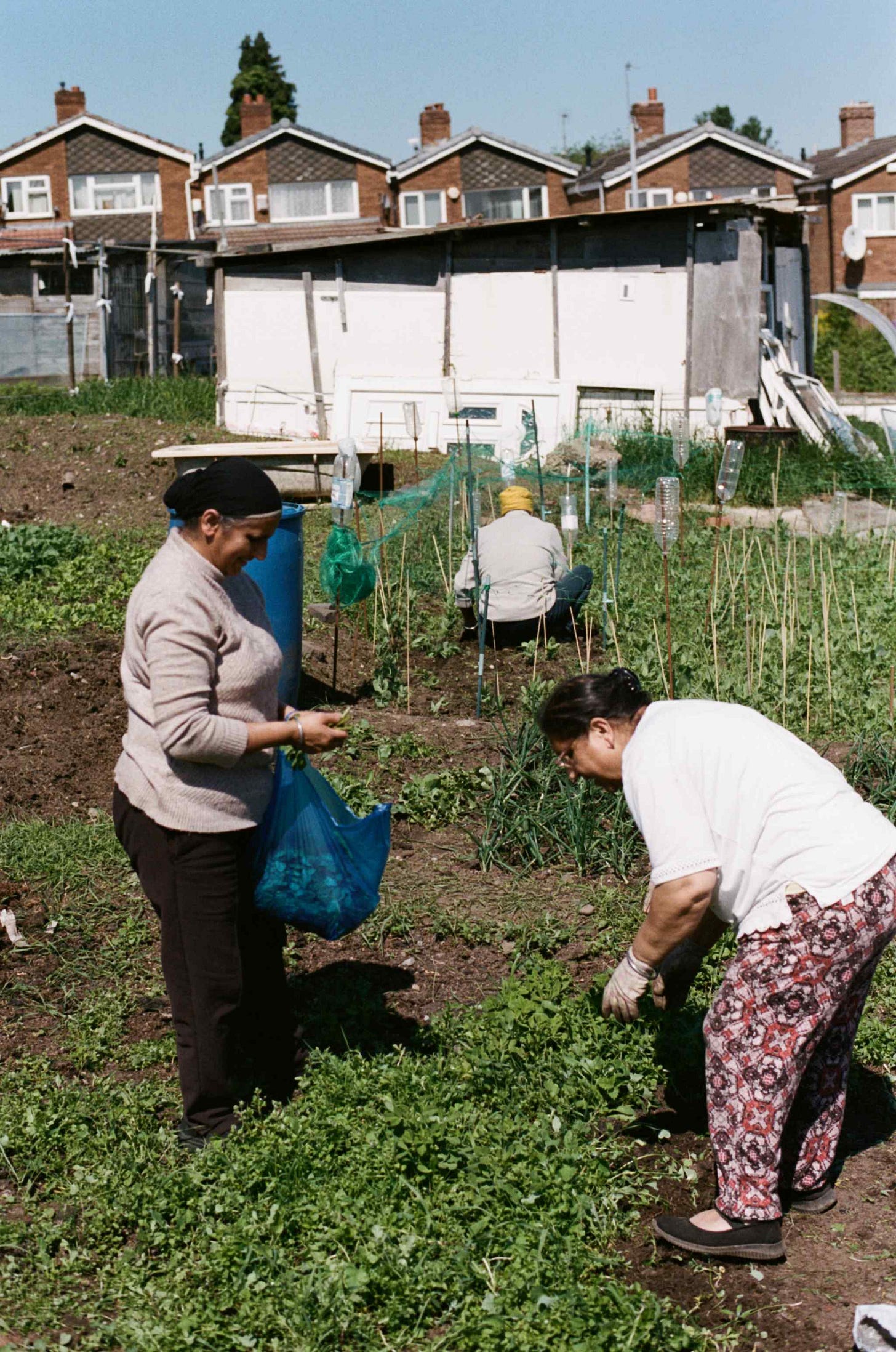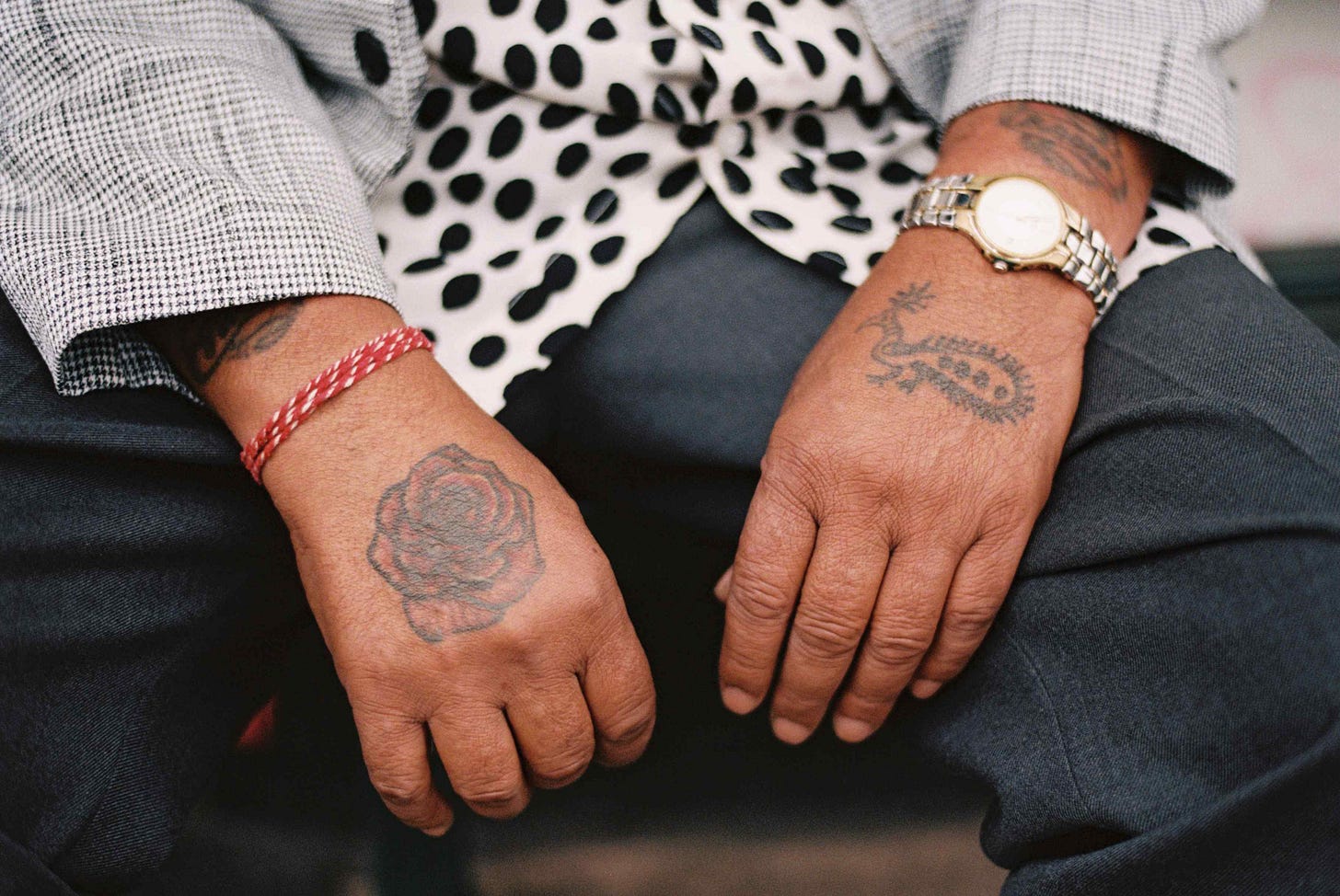From Ludhiana to Smethwick, grass roots run deep
I spent a morning at Stony Lane allotments in Smethwick, where local families have brought Punjabi farming culture to British soil. Photography by Hark1karan from his new book, Grass Roots

This story is a collaboration with Vittles Magazine, where it was originally published.
At the beginning of 2021, South London-based photographer Hark1karan received a message on Twitter from a woman called Talvinder Kaur Rana, or Thindi. She’d been following his work and asked if he could travel up to Smethwick, in the Black Country, where she grew up, to take portraits of her dad with his friends on their allotment as a gift.
Hark1karan had been to Smethwick before. He’d slept at Guru Nanak Gurdwara, a Sikh temple whose domed roof towers over local residential streets, while cycling from Birmingham to Southall, West London, via Luton, as part of the Sikh Arts and Cultural Association’s charity bike ride. “I’ve been to quite a few allotments, but this one is different. I’ve never seen anything like it,” he told me over a beer earlier this summer. “It’s British, but it’s also very Punjabi.”
The 35-year-old has been documenting the lives of British Sikhs and Punjabis with his camera for the best part of a decade. I first connected with him in 2020, during the first lockdown, after I discovered his debut book, PIND: Portrait of a Village in Rural Punjab. For his second, KISAAN: The Farmers’ Protest 2020-2021, he spent 24 hours with his ancestral village at the climax of the year-long morcha (sit-down protest) on the outskirts of Delhi, two weeks before victory in November 2021.
Six months earlier, the protest had been in full swing when he made his first visit to the Stony Lane allotments. Green and yellow flags of support for farming unions in India flapped in the wind. His return trip in August would create the crisp, overcast images of his latest book, Grass Roots, a portrait of the Sikh Punjabi community who’ve made this quiet, post-industrial part of the West Midlands their home, its earth a source of sustenance and ancestral connection.
“It’s about growth. These are our roots, here and back home. But also, what I do is grass roots. The way it happened is grass roots,” says Hark1karan. The book’s title is also a nod to the album of the same name by UK bhangra legend Panjabi MC – who Hark1karan and I profiled for the Guardian last year – which the producer-DJ recorded in a studio in Ludhiana, India, using the sound of a dripping tap as a metronome. On its release in 1996, Grass Roots, whose original iteration is not available on streaming platforms because its samples weren’t cleared at the time, was one of the first projects to lay rustic Punjabi folk vocals over pre-millennium Black Atlantic genres like hip hop, soul and jungle, years before anyone discovered “Mundian To Bach Ke”.
The roots of Punjabi presence in the West Midlands stretch back to the 1950s and ’60s, when, following the region’s bloody partition into east and west, India and Pakistan, families from the spliced land of the five rivers settled in the Black Country. On arrival in Smethwick, men worked manual jobs at places like the Birmid Qualcast Foundry, Fancy Plastic Factory and Tristar Shoes in Lozells. A lack of choice required them to master the heavy, man-made mechanics of industry, but many of them had origins in rural Punjab and were armed with growing skills and intuitions for caring for the land.
Grass Roots introduces many of these first-generation characters who, arriving as children during the first wave, or as young adults ever since then, brought the farming knowledge and practices of their forefathers to British suburban soil. They refer to the allotments, which started in the mid-twentieth century, shortly before their arrival, as “the gardens” in casual conversation. A man called Chainchal Singh was one of the first Punjabis to start growing there in the 1970s. He recently stopped visiting due to ill health and old age. Pal Singh Sanghera, the former head chef of the local wedding catering company, grows award-winning pumpkins. Malkit Singh Hayer, who has large, colourful hand tattoos, one of a rose and the other of a peacock, likes to host other growers on seats outside his shed beside a portable speaker playing bhangra.
In Hark1karan’s photos, men and women gather among flowers, bathtubs collecting rainwater and single leather shoes suspended from poles wedged into the soil (to protect crops against the evil eye and bad omens). Inside their private sheds, fold-up chairs are arranged around coffee tables, kambal blankets are laid out on manjas (woven beds), empty whisky bottles collect dust and gardening tools are wedged onto wooden shelves. Colourful illustrations of Sikh gurus, scenes from village life and characters from Punjabi folklore, posters of famous singers and muscled wrestlers, Father’s Day cards, flower garlands and newspaper cut-outs are stuck to the walls. Gardeners rest, socialise, brew chaa early in the morning and deep fry pakora made of besan-coated leaves, onions and potatoes plucked from the earth moments before.
“Allotments are British, and the things that are done on them, seasonally, are British. But the way they’ve done it, what they grow and the things they do, is very Punjabi. The colours, the flags, the vegetables, the way they all look,” says Hark1karan. “People talk a lot now about finding their own space to meditate in modern life. Everyone is looking for spirituality. These guys have created that for themselves. They have their own space. It’s forward-thinking, but also comes back to who they are and where they come from, which is farming. Punjabis farm. They’ve kept that alive.”
Earlier this summer, I drove up to Smethwick to visit the allotments with my dad. We were greeted by Thindi and her dad, Harjinder Singh Rana, who started growing there 22 years ago. They welcomed us into a shed to drink cups of chaa poured from a steaming pan and eat samosas alongside a bright, sweetened, chilli chutney.
Eating with my hands and sipping a hot drink from a mug while struggling to understand the language being spoken in the next room took me back to when dad and I broke bread like this in January, during the two weeks we spent together in Punjab. In Ludhiana, we tracked down the room where he was born; in Amritsar, we stopped to eat kulcha thalis and fish fry, finding tranquillity on the swept marble steps beside the city’s sarovars (holy lakes). Above our heads, teenagers flew paper kites on the seasonal breeze. Away from the cities, we ate saag and makki ki roti at a farm overlooking flat fields of yellow mustard flowers.
On the allotment, dad spoke to Harjinder and the other men in Punjabi while I spoke to Thindi in English. She recalled memories of picking peas with her sister on weekends, helping to carry produce home for her mum to prepare and eating kadhu (pumpkin) sabji and halwa to the point of tedium. She explained that the revered summer vegetable of karela, or bitter melon – whose natural bitterness is said to offset the sweetness of the mango that likely follows it for dessert – can’t be grown in the British climate. Instead, they grow mini versions called kundru, or ivy gourd.
Other adaptive variations like this exist, too. According to Harjinder, softer aubergines are grown on the allotments than in Punjab. Here, green chillies require the heat of a greenhouse and are therefore a relatively new addition. A long, diverse list of fruit, vegetables, herbs and grains are otherwise grown: spinach, spring onion, garlic, leek, potato, methi (fenugreek), coriander, chapar kadhu (Indian summer squash), marrow, tomato, courgette, blackberry, apple, gooseberry, beetroot, runner bean, broad bean and maize flour.
Hark1karan compares the upholding of farming rituals to the way that many British Punjabis collect and modify classic BMWs. This subculture, which evolved beside the popularity of dub reggae music in multicultural pockets of British cities, is explored in his 2022 short documentary Zimmers of Southall. These are practical, hand-me-down hobbies that facilitate community, knowledge-sharing and familial pride; inherited forms of diasporic masculinity. They take place mostly IRL, teaching patience, solitary contentment and technical collaboration, away from the frenzied hype of digital culture.
“The allotment is the same thing as the cars. They’re just into it, they’re doing something they’re passionate about, and it’s happening offline, so people don’t see it as much. These people are doing skilled things, they’re immersed in British life, but they still have their identity. It goes against the narrative that people are losing their identities,” he says. “In cities in the UK, we often don’t have much interaction with nature or [have the] space to grow things. But in village life, you are interacting with people. You have plots of farmland next to each other and that is replicated on the allotments. In general, life is a bit slower as you leave London. That brings it closer to life in Punjab.”
Thindi took us on a walk around the paths that separate each grower’s plot of land. A man called Gurmukh Singh rushed over and asked us to look at his potatoes. Mohinder Singh Hayer handed me a plastic bag containing a box full of freshly picked strawberries. A couple sitting on stools wearing gardening gloves worked quietly together; one of their plots was covered with blue netting to prevent rodents from nibbling on their plants.
With new copies having just arrived, Grass Roots was the talk of the allotment. It is small and bendable, like a thick pamphlet one might pick up from a town hall meeting. But it carries the rare care and hardened sturdiness of a collector’s item. A dust jacket folds out to reveal an image of chickens clucking by a pile of metal construction material and a potted apple tree. Its design, front cover and postcards of artwork inside are the work of other artistic collaborators in Hark1karan’s network.
“All of these projects and things I’m working on, they’re just happening naturally. The seed was planted. I thought it was going to grow into a nice flower, but actually it’s turning into a big oak tree with a lot of branches,” he reflects on the evolution of his creative archive. “It’s hard to tell a story of a community in one story, so you have to have little stories, like chapters from a book. That’s what it’s turning into. The focus is on a particular group, but it is relatable to any group of humans on this planet.”
Dad and I bid our goodbyes to walk to the nearby high street to buy some Pakistani mangoes from a bustling greengrocer. A few doors up from Smethwick Library and the area’s main gurdwara, whose kitchen’s service of langar, like several other gurdwaras in the region, is supplied by produce from the allotment, stands the Blue Gates Hotel. This is where Malcom X famously visited days before his assassination in 1965. A blue plaque celebrating his short life is pinned to the side of a nearby residential house. Back then, the hotel operated a colour bar, banning non-white drinkers. Now it’s a desi pub, a symbol of the town’s unique shift from one of the most racist places in the UK, a seat of power for the far-right politician Enoch Powell in the mid-1960s, to its current status as a tolerant, multicultural community.
Before we left, we needed to eat. We drove to Rolfe Street, where derelict, hollowed-out factories from Smethwick’s industrial era still stand alongside thriving Mercedes car garages and warehouses selling wholesale construction materials. We entered Golu Da Dhaba, a vegetarian canteen at an acute street corner, and ordered a tin plate of channa bhature each, with a side of chilli soya chaap to share. The windows’ frosted effect at head height meant we couldn’t clearly look out of them onto the road. The sensual combination of bright, muted light from the cloudless sky peeking through the translucent glass, the bangs of industrial workmanship outside, and the deep, buttery flavours of the meal, made it feel a bit like we were back in Ludhiana, sitting at my dada-ji’s favourite sweetshop in Chaura Bazaar.
By Ciaran Thapar. This article was originally published in Vittles Magazine.
Grass Roots is available to buy for a second limited print run from its publisher, Out of Place Books.












Absolutely wonderful. Thanks.